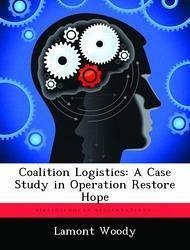This thesis investigates US Army logistics support provided to coalition forces in Somalia using US Army Field Manual 100-5, Operations, as the standard. This research examines the history of US involvement in coalition operations. It also analyzes the tactical logistics functions as applied to US Army logistics support to coalition forces during Operation Restore Hope. In each function, US Army logisticians provided coalition partners the support required. The author recorded and analyzed the specifics of each function. FM 100-5 considers coalition operations as ad hoc missions. Virtually no logistical doctrine is available for coalition operations. This thesis concludes that the logistics support met minimum requirements. The US Army, however, achieved this through innovative logistics techniques by leaders at all levels in United States Central Command and in Joint Task Force Somalia and not by any existing doctrine. Due to differences in standards among potential coalition partners, future operations must consider increased interoperability of equipment, personnel, and training. Coalition logistics must be continually refined to become a realistic part of US Army training and doctrine.
Hinweis: Dieser Artikel kann nur an eine deutsche Lieferadresse ausgeliefert werden.
Hinweis: Dieser Artikel kann nur an eine deutsche Lieferadresse ausgeliefert werden.








